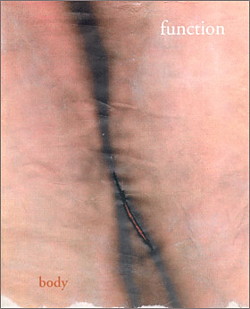2001 – Introduction – Function #3
Body
Body / mind
Body image, body language
Body type
Body structure, body part
Bodily function
Body art
Body piercing
A body of…
The embodiment of…
Body. Few words in this culture have such weight, or are so full of suggestion and association. The body is a home for each of us, but we do not dwell there with much ease; and we acknowledge this as we buy, sell, transplant, rent, barter or freeze our fluids, tissue, organs, wombs, eggs, sperm and endless other fragments of what were once our selves. This activity seems only to increase with scientific progress, as the advances of the Human Genome Project further disassemble what we originally thought our bodies were.
Despite all this, no one has really solved the central problem of the body’s impermanence, described so efficiently in the writings of Dogen, who lived in Japan three-quarters of a millennium ago:
We are born in the morning and die in the evening; the man we saw yesterday is no longer with us today. These are facts we see with our own eyes and hear with our own ears. You see and hear impermanence in terms of another person, but try weighing it with your own body….[1]
Who has a good response to this problem? Who really can weigh it with their own body? And who can find the words to express something that might serve as a response?
As we think about the body, its conditions and existence, we bring images to mind; this is a natural part of the search for permanence and meaning. An image lasts longer than a moment; it states a point of view more quickly than a sentence; it incorporates an attitude or symbolizes a question more readily than a paragraph. We see – all at once – an entire complex of ideas, held in the frame for us to examine in our own time. Images do not necessarily yield answers to our questions, but they do provide another way to think about them.
The images in this issue show places we may not have been, people we may not have known, parts of histories and of lives that can be contemplated after the fact. They also show faces and bodies: masks and attitudes, instants, expressions and poses; details, vantage points, movements and gestures; glimpses; times, seasons and activities; symbols and representations of otherness, and finally, constructed realities. They do this with a kind of lightness and directness that contrasts well with the problematic nature of some of the words listed earlier, without ever camouflaging the questions these words bring up.
We have time on these pages, looking and thinking, to question our fears and ideals, to delay impermanence, to activate memory and to examine the existence of others as well as ourselves, using a shared visual language. Doing this brings its own rewards. Most of these images are affirmative in tone, and most bring us back to the idea of the body as a home for our being and the seat of our consciousness. The body is depicted here as something to be appreciated in its entirety and its unity rather than deconstructed in a climate of scientifically driven uncertainty.
Half a world away and more than three centuries after Dogen, Shakespeare also wrote of impermanence, but in quite different terms. His best descriptions of this condition are full of visual images, but they speak of acceptance in the face of impermanence. The famous sonnet (#73) on aging and death describes these occurrences accurately, but does not divide the body from the mind, or ask the reader to solve an unfathomable problem; it asks, rather, that one see clearly –
This thou perceiv’st, which makes thy love more strong,
– and suggests a possible resolution for what is seen:
To love that well which thou must leave ere long.
March 2001
Notes:
1. Dogen-zenji (1200-1253), quoted in The Roaring Stream, ed. Foster and Shoemaker, p. 210

